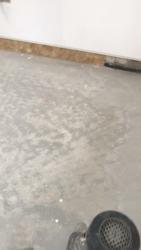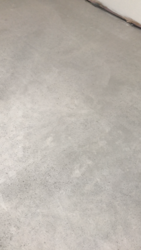You should not use pva on any screed that is to be tiled
-
Show us YOUR Work thread - 500,000 VIEWS and Counting! Last Post/Page - Please Add Your Latest Tile Projects
(Here is the old read-only thread, it has 125,000 tile pictures)
You are using an out of date browser. It may not display this or other websites correctly.
You should upgrade or use an alternative browser.
You should upgrade or use an alternative browser.
Search the forum,
Well to be honest, can you trust his judgement?
And “doesn’t seem to think” is exactly the definitive answer you require.
I’ve recently laid over 100m2 of 120 x 120 x 6mm thin tile on to a liquid cement based screed, and all the information supplied stated laitance free, and does not need sanding.
Un-sanded.

The darker patches are surface laitance, you can not adhere to this, it will separate at some point.
You mentioned a thin skin on the bottom of the adhesive!!
This does not mean it no longer needs sanding, for peace of mind I’d still want it done.
A 60# grit copper disc on a floor polisher type machine should work easily enough.
Sanded.
If you expand the image you can see the aggregates in the screed, that’s what we prefer to see before sticking even a mat to it.
When I say we, I mean the crew I personally work with.

Priming is an exact process too.
If it’s applied in coats that are too strong, it can form a skin instead of soaking in to thescreed.
Then you’re sticking to the skin and not the floor.
First coat should be very weak, 5/6-1 with water.
Second, slightly stronger.
If it’s still drying instantly, it could have another coat.
But it must soak in and not pool on the surface.
But your tiler should know this.
I would also insist on a 1mm antifracture mat on top of the screed too, before it was tiled.
As far as the product suggested above, Bal Flexbone 2easy.
Personally have no experience as yet with it, so I can’t comment on its suitability I’m afraid.
But it’s all assumption, very difficult to pin point all the reasons it’s failed without seeing it in the flesh.
Discuss Newbie looking for advice on tiles lifting! in the Canada Tile Advice area at TilersForums.com.
O
Old Mod
The colours on your images are not very clear, it’s hard to distinguish between them.
The fact that the floor is immaculate and all the adhesive is stuck to the tile would suggest improper preparation.
Is there a thin layer on the adhesive that is a similar colour to the floor?
As if the adhesive has pulled a thin film of the floor up?
Your floor may have been down 6 months but was the house water tight when it went in?
I know how agreeable the weather can be there.
Were your patio/bi-folds doors fitted, or was the back maybe sheeted out instead?
There is no guarantee it was dry, it should have been tested for moisture.
And yes PVA primer is completely incorrect as a primer for your floor.
Use the primer stated on the back of the adhesive bag, that’s why the info is on there.
And yes it does matter, if only to ensure your product guarantees remain in tact.
Was your floor sanded before the floor install?
Even liquid cement floors can need laitance removal first.
The fact that the floor is immaculate and all the adhesive is stuck to the tile would suggest improper preparation.
Is there a thin layer on the adhesive that is a similar colour to the floor?
As if the adhesive has pulled a thin film of the floor up?
Your floor may have been down 6 months but was the house water tight when it went in?
I know how agreeable the weather can be there.
Were your patio/bi-folds doors fitted, or was the back maybe sheeted out instead?
There is no guarantee it was dry, it should have been tested for moisture.
And yes PVA primer is completely incorrect as a primer for your floor.
Use the primer stated on the back of the adhesive bag, that’s why the info is on there.
And yes it does matter, if only to ensure your product guarantees remain in tact.
Was your floor sanded before the floor install?
Even liquid cement floors can need laitance removal first.
Last edited by a moderator:
Yes it looks as if it had pulled a thin layer off the floor alright, I’m not sure why they used pva sealer on the floor! The house was 100% weather tight! All new windows and doors had been in place long before the screed had been poured! No preparation was done on the floor apart from being sealed!
The tiles all have to come up but does anyone know the proper procedure now to stop this happening again! The tiler doesn’t seem to think the floor needs sanded
The tiles all have to come up but does anyone know the proper procedure now to stop this happening again! The tiler doesn’t seem to think the floor needs sanded
Andy Rhodes
TF
If that's was the case and your tiler did no prep work the 5 P's motto comes to my mind, poor preparation **** poor performance
You mentioned the tiler had back buttered the tile (good) but then laid onto dot and dabs (bad). The tiler should have achieved 100% adhesive coverage to the floor, but the image shown shoes a coverage of about 60%. A professional tiler would not lay these tiles using the dot and dab method, irrespective of back buttering the tiles. However, the way the 'dabs' have lifted cleanly is suspicious. Triple check the floor is not gypsum/anhydrite. Suggest you use a de-coupling membrane next time such as the new BAL Flexbone 2 Easy;
BAL Flexbone 2Easy Matting - https://www.tilefixdirect.com/product/BAFBONE-2EASY
BAL Flexbone 2Easy Matting - https://www.tilefixdirect.com/product/BAFBONE-2EASY
O
Old Mod
The tiler doesn’t seem to think the floor needs sanded
Well to be honest, can you trust his judgement?
And “doesn’t seem to think” is exactly the definitive answer you require.
I’ve recently laid over 100m2 of 120 x 120 x 6mm thin tile on to a liquid cement based screed, and all the information supplied stated laitance free, and does not need sanding.
Un-sanded.

The darker patches are surface laitance, you can not adhere to this, it will separate at some point.
You mentioned a thin skin on the bottom of the adhesive!!
This does not mean it no longer needs sanding, for peace of mind I’d still want it done.
A 60# grit copper disc on a floor polisher type machine should work easily enough.
Sanded.
If you expand the image you can see the aggregates in the screed, that’s what we prefer to see before sticking even a mat to it.
When I say we, I mean the crew I personally work with.

Priming is an exact process too.
If it’s applied in coats that are too strong, it can form a skin instead of soaking in to thescreed.
Then you’re sticking to the skin and not the floor.
First coat should be very weak, 5/6-1 with water.
Second, slightly stronger.
If it’s still drying instantly, it could have another coat.
But it must soak in and not pool on the surface.
But your tiler should know this.
I would also insist on a 1mm antifracture mat on top of the screed too, before it was tiled.
As far as the product suggested above, Bal Flexbone 2easy.
Personally have no experience as yet with it, so I can’t comment on its suitability I’m afraid.
But it’s all assumption, very difficult to pin point all the reasons it’s failed without seeing it in the flesh.
Still no reason as to why the tiles have lifted! Waiting on a report from the rep of the screed product! The rep said that with having a liquid screed in the extension and normal sand cement screed in the house we will need an expansion joint to stop the tiles cracking! Our tiler has suggested using the anti fracture Matt but can this be used between the sand cement screed and the liquid screed?
J
J Sid
a mat will be good but will definitely need a expansion joint across ufh in new area. Would of expected there to have been an expansion joint put in by screed contractor between new and old.
D
Dumbo
Anti fracture mat if used would be over the whole area not just the join . But it is not a substitute for an expansion joint.Still no reason as to why the tiles have lifted! Waiting on a report from the rep of the screed product! The rep said that with having a liquid screed in the extension and normal sand cement screed in the house we will need an expansion joint to stop the tiles cracking! Our tiler has suggested using the anti fracture Matt but can this be used between the sand cement screed and the liquid screed?
J
J Sid
I wouldn't put it over joint.
Reply to Newbie looking for advice on tiles lifting! in the Canada Tile Advice area at TilersForums.com
There are similar tiling threads here
I had a small leak in the main water line before the stop tap in my 1950s house. The copper pipe...
- Replies
- 1
- Views
- 689
Hi!
I'm looking for some advice, I have laid some SLC (Mapei 1210) in our conservatory in...
- Replies
- 5
- Views
- 691
Good morning all.
After a little advice. I'll post pictures a bit later. However....
The...
- Replies
- 6
- Views
- 968
Posting a tiling question to the forum? Post in Tilers' Talk if you are unsure which forum to post in. We'll move it if there's a more suitable forum.
Advertisement
New Tiling Questions
-
UK WICKES MISSISIPPI GREY TILEI am looking for 1 wickes Mississippi grey tile - damaged 1 tile in my kitchen and they have been discontinued 😭😭 looked everywhere online - wondered if anyone could help😞
- Started by Jashcroft
- Replies: 0
-
UK Do I need to tank shower over bathtub?https://www.tilersforums.com/threads/shower-bath-tiling-preparation-plaster-and-wooden-windowsill.83462/#gsc.tab=0 There was some heated argument in the above thread! I don't have much...
- Started by bureaucrazy
- Replies: 1
-
Unevenness of the wall to be tiledHello, I am a noob trying to tile our shower. Since the old tiles were taken off, some of that wall material has been taken off as well, so everything had to be smoothed. After smoothing with some...
- Started by blackarrow1990
- Replies: 6
-
Brilliant Tiling Advice Provided and Peer-Reviewed via 1000’s of Tilers Discussion ThreadThis is the Brilliant Tiling Advice Provided and Peer-Reviewed via 1000’s of Tilers Discussion Thread How do you know Tiling Advice is Trusted? When its peer reviewed and treated scientifically...
- Started by Dan
- Replies: 0
-
A Friend of ours, UK Tiling Forum, is worth a mention for sure Discussion ThreadThis is the A Friend of ours, UK Tiling Forum, is worth a mention for sure Discussion Thread We have this Tile Blog here, and a few other websites lets say. We will be adding to the blog during...
- Started by Dan
- Replies: 1
Replies you've not seen
-
UK WICKES MISSISIPPI GREY TILEI am looking for 1 wickes Mississippi grey tile - damaged 1 tile in my kitchen and they have been discontinued 😭😭 looked everywhere online -...
- Latest: Jashcroft
-
UK Do I need to tank shower over bathtub?I would waterproof the area, windowsill as well. The bathtub needs to be solid. Create a seal along the tub using Schluter Kerdi Fix, Send us more...
- Latest: Tile Marble Granite
-
Unevenness of the wall to be tiledWhat brand waterproofing are you using?
- Latest: Tile Marble Granite
-
2024 Show us all YOUR Tile Work (new 2024 thread)Was a full room custom ensuite install made to measure vanity, bulkhead for the stairs is in bottom drawer of the vanity unit
- Latest: Kastar UK
-
I'm Looking For This Tile White bumpy ceramic wall tilesMany thanks for the tip AliGage
- Latest: joncee


